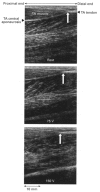In vivo human tendon mechanical properties
- PMID: 10562354
- PMCID: PMC2269645
- DOI: 10.1111/j.1469-7793.1999.00307.x
In vivo human tendon mechanical properties
Abstract
1. The aim of the present study was to measure the mechanical properties of human tibialis anterior (TA) tendon in vivo. 2. Measurements were taken in five males at the neutral ankle position and involved: (a) isometric dynamometry upon increasing the voltage of percutaneous electrical stimulation of the TA muscle, (b) real-time ultrasonography for measurements of the TA tendon origin displacement during contraction and tendon cross-sectional area, and (c) magnetic resonance imaging for estimation of the TA tendon length and moment arm. 3. From the measured joint moments and estimated moment arms, the values of tendon force were calculated and divided by cross-sectional area to obtain stress values. The displacements of the TA tendon origin from rest to all contraction intensities were normalized to tendon length to obtain strain values. From the data obtained, the tendon force-displacement and stress-strain relationships were determined and the tendon stiffness and Young's modulus were calculated. 4. Tendon force and stress increased curvilinearly as a function of displacement and strain, respectively. The tendon force and displacement at maximum isometric load were 530 N and 4.1 mm, and the corresponding stress and strain values were 25 MPa and 2.5 %, respectively. The tendon stiffness and Young's modulus at maximum isometric load were 161 N mm-1 and 1.2 GPa, respectively. These results are in agreement with previous reports on in vitro testing of isolated tendons and suggest that under physiological loading the TA tendon operates within the elastic 'toe' region.
Figures




References
-
- Alexander RMcN. Mechanics of skeleton and tendons. In: Brook B, editor. Handbook of Physiology, The Nervous System. Vol. 2. Bethesda: American Physiological Society; 1981. pp. 17–42. section A.
-
- Bennett MB, Ker RF, Dimery NJ, Alexander RMcN. Mechanical properties of various mammalian tendons. Journal of Zoology, London. 1986;209:537–548. A.
-
- Butler DL, Grood ES, Noyes FR, Zernicke RF. Biomechanics of ligaments and tendons. In: Hutton RS, editor. Exercise and Sport Science Reviews. vol. 2. Philadelphia: The Franklin Institute Press; 1978. pp. 125–181. - PubMed
-
- Cook CS, McDonagh MJN. Measurement of muscle and tendon stiffness in man. European Journal of Applied Physiology. 1996;72:380–382. - PubMed
MeSH terms
LinkOut - more resources
Full Text Sources
Other Literature Sources

